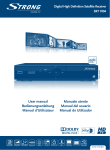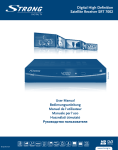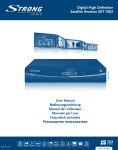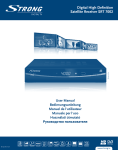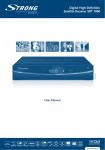Download User manual Bedienungsanleitung Manuel d'Utilisateur Manuale
Transcript
Picture similar Digital High Definition Satellite Receiver SRT 7004 User manual Bedienungsanleitung Manuel d’Utilisateur Manuale utente Manual del usuario Manual do Utilizador PART 1 • English 18 Oct 2013 20:17 1.0 Instruction 1.1 Safety Instructions 1.2 Storage 1.3 Equipment Set-up 1.4 Accessories 1.5 Usage of external USB devices 2.0 Your Receiver 2.1 Default PIN: 0000 2.2 Front panel 2.3 Rear panel 2.4 Remote Control 2.5 Installing the batteries 2.6 Using the remote control 3.0 Connections 3.1 Basic connection using a Scart cable 3.2 Basic connection using an HDMI cable 3.3 Connecting multiple fixed LNBs using a DiSEqC 1.0/1.1 switch 3.4 Connecting to Ethernet 4.0 First Time Installation 4.1 Installation 5.0 Quick guide for using your receiver 6.0 Operation 6.1 Changing channels 6.2 Info banner 6.3 Selection of audio language 6.4 Teletext 6.5 Subtitles 6.6 EPG (Electronic Programme Guide) 6.7 Favourite channels 7.0 Main Menu 7.1 Installation 7.2 Channel 7.3 Multimedia 8.0 Troubleshooting 9.0 Specifications 2 2 2 3 3 3 4 4 4 4 4 5 6 6 6 6 6 7 7 7 8 8 8 9 9 10 10 10 10 10 10 14 21 23 24 STRONG declares that this item complies with the basic requirements and other relevant regulations of directives CE 2004/108/EC and 73/23/EC, RoHS 2002/95/EC Subject to alterations. In consequence of continuous research and development technical specifications, design and appearance of products may change. HDMI, the HDMI logo and High-Definition Multimedia Interface are trademarks or registered trademarks of HDMI Licensing LLC in the United States and other countries. Dolby and the double-D symbol are registered trademarks of Dolby Laboratories. All other product names are trademarks or registered trademarks of their respective owners. © STRONG 2013. All rights reserved. 1 English Table of Contents PART 1 • English 1.0 Instruction 1.1 Safety Instructions DO NOT INSTALL YOUR RECEIVER: In a closed or poorly ventilated cabinet; directly on top of or under any other equipment; on a surface which might obstruct the ventilation slots. DO NOT EXPOSE THE RECEIVER OR ITS ACCESSORIES: To direct sunlight or any other equipment that generates heat; to rain or intense moisture; to intense vibration and to any shock which may cause permanent damage to your receiver or to any magnetic objects, such as loudspeakers, transformers, etc. Do not use a damaged power cord. It may cause a fire or an electric shock. Do not touch a power cord with wet hands. It may cause an electric shock. When the receiver is not used for a long period of time, you should unplug the power cord from the wall socket. Do not use alcohol or ammonia based liquids to clean the receiver. If you wish, you may clean your receiver with a soft lint-free cloth slightly made damp with a mild soap solution, and only after disconnecting from the mains voltage supply. Make sure no foreign objects fall through the ventilation slots because this could cause fire or an electric shock. Do not place any objects on top of the receiver because this might prevent proper cooling of the components inside. Safety Precautions Never try to open the receiver. It is dangerous to touch the inside of the receiver due to high voltages and possible electrical hazards. Opening the receiver will void the warranty of the product. Refer all maintenance or servicing to suitably qualified personnel. When you are connecting cables, be sure that the receiver is disconnected from the mains supply voltage. Wait a few seconds after switching off the receiver before you move the receiver or disconnect any equipment. It is a necessity that you only use an approved extension and compatible wiring that is suitable for the electrical power consumption of the installed equipment. Please ensure that the electrical power supply corresponds with the voltage on the electrical identification plate at the back of the receiver. If the receiver does not operate normally even after strictly following the instructions in this user manual, it is recommended to consult your dealer. 1.2 Storage Your receiver and its accessories are stored and delivered in a packaging designed to protect against electric shocks and moisture. When unpacking it, make sure that all the parts are included and keep the packaging away from children. When transporting the receiver from one place to another or if you are returning it under warranty conditions, make sure to repack the receiver in its original 2 packaging with its accessories. Failing to comply with such packaging procedures could damage the product and void your warranty. 1.3 Equipment Set-up We recommend you consult a professional installer to set up your equipment. Otherwise, please follow the instructions below: Refer to the user manual of your TV and your antenna. Make sure that the SCART/HDMI cable and outdoor components are in a good condition and the SCART/HDMI connections are well shielded and from good quality. This manual provides complete instructions for installing and using this receiver. The following symbols will serve as follow. WarningIndicates warning information. NoteIndicates any other additional important or helpful information. MENURepresents a button on the remote control or the receiver. (Bold Characters) Move toRepresents a menu item within a window. (Italic Characters) 1.4 Accessories 1 user manual 1 remote control 2x batteries (AAA type) Note:The batteries should not be recharged, disassembled, electrically shortcircuited or be mixed or used with other types of batteries. If rechargeable accumulators instead of batteries are going to be used, we recommend using (e.g. NiMH) types with low self-discharge to ensure long time operation of remote control. 1.5 Usage of external USB devices It is recommended to use USB 2.0 storage devices. If your device is not compatible to USB 2.0 specifications, multimedia functions of the receiver might not work properly. STRONG cannot guarantee compatibility with all types of USB storage devices. It is advised not to store important information on USB storage devices used with the receiver. Always make backups of data on your USB storage device before using it with this receiver. STRONG will not take responsibility for any loss of information or circumstances caused by loss of information. Please ensure that either the USB device is already formatted to FAT/FAT32, or format the USB device via your receiver, refer to chapter 7.3 Multimedia for details. 3 English PART 1 • English PART 1 • English 2.0 Your Receiver 2.1 Default PIN: 0000 2.2 Front panel Fig. 1 1. USB:For connection of USB pen drive for software upgrade storage devices 2. LED display:Shows channel number in operation and time in Standby 3. Power button:Switch the receiver to Standby or On. 4. Standby indicator:Shows power state of the receiver Green LED - receiver is turned on Red LED - receiver is in standby mode 5. MENUOpen the main menu. 6. Remote control sensor: Receives the signal from the remote control 7. CH-/CH+:To change channels without using the remote control 8. VOL-/VOL+Decrease/Increase audio volume. 9. OKConfirm settings. VOL-/VOL+ and CH+/CH- double as navigation buttons when in menu. 2.3 Rear panel Fig. 2 1. EthernetTo connect to a network switch, router or modem 2. SAT INTo connect to the LNB of your satellite dish for reception of satellite broadcast signal 3. SAT OUTTo loop through the satellite signal to a second receiver 4. S / PDIF coaxialTo connect to a digital or home cinema audio amplifier 5. USBFor connection of USB device for Multimedia use 6. HDMITo connect to the HDMI input of your TV using a good quality HDMI cable. 7. TV SCARTTo connect to TV using a SCART cable 8. DC powerTo connect to the original included main power adapter (Input 100 ~240V 50~60Hz/ Output 12 V DC 2.4 Remote Control 1. 2. 3. 4. 5. 6. 4 qTurns the receiver ON/Standby !To turn the sound on or off. REDFlexible functions in OSD menu and Teletext GREENFlexible functions in OSD menu and Teletext. YELLOWFlexible functions in OSD menu and Teletext. BLUEIn viewing mode: displays the schedule menu for easy setup timers; Flexible functions in OSD menu and Teletext. Fig. 3 7. SUBTITLETo select subtitles language out of available ones on the current channel 8. TEXTTo open Teletext if available on the current channel. 9. AUDIODisplays the audio selection menu with selections for available languages and audio modes 10.RECALLTo switch between the last viewed channels. 11.5Searches backwards during playback. Each pressing increases the speed (x2 – x32) 12.6Searches forwards during playback. Each pressing increases the speed (x2 – x32) 13.7Jumps to the previous file during playback. 14.8Jumps to the next file during playback. 15.1Starts/resumes the playback. 16.2Freezes the playback of multimedia files. 17.3Stops playback of multimedia files. 18.4Optional. Please see www . strong . tv 19.MENUTo open the main menu in viewing mode or to go one step back in the menu 20.EXITCancellation of current process/exit from main menu to viewing mode 21.pqSwitches to the next/previous channel in viewing mode, switches to the next/previous page in channel list or moving the highlight up/down in the menu. 22.OKViewing mode: Displays the channel list. Menu: activation of the highlighted item 23.tuDecreasing/increasing the volume level in viewing mode/ navigating through the menus/changing values of settings in a menu 24.EPGViewing mode: Displays the EPG (Electronic Programme Guide) 25. Press once to display channel number/name and current/coming information. Press twice to display detailed event information. Press three times for transponder/signal strength information. Press again to get back to viewing mode. 26.V+/V-Increases/decreases the volume level in TV mode 27.FAVTo access your favourite channels. Toggles between available favourite groups 28.GOTOIn playback mode: opens the time banner for selection the moment where to jump. 29.P+/P-Jumps 10 places up or down in channel list. 30.0-9Channel number and numeric value input 31.OPTNo function 32.TV/RADIOToggles between TV and radio mode 2.5 Installing the batteries Fig. 4 5 English PART 1 • English PART 1 • English Remove the battery cover from the remote control and put 2x AAA size batteries inside the compartment. The diagram inside the battery compartment shows the correct way to install the batteries. 1. Open the cover 2. Install batteries 3. Close the cover NOTE:The batteries should not be recharged, disassembled, electrically shortcircuited, be mixed or used with other types of batteries. 2.6 Using the remote control Fig. 5 To use the remote control, point it towards the front of the digital receiver. The remote control has a range of up to 7 metres from the receiver, if properly aligned towards the IR eye on the front panel. The remote control will not operate if its path is blocked. note:Sunlight or very bright light (such as TL lighting) might decrease the sensitivity of the remote control. 3.0 Connections For basic setup with 1 dish + 1 LNB: Connect the satellite cable to the SAT IN connector on your receiver. For advanced dish setup, refer to section 3.3 3.1 Basic connection using a Scart cable Fig. 6 1. Connect the LNB of your satellite antenna to the SAT IN connector of your receiver using a good quality coax cable and suitable ‘F-connector’ plugs. 2. Connect one end of a good quality Scart cable to the TV SCART connector on your receiver and the other end to the SCART input of your TV. 3. Plug the power cord to a suitable wall outlet. 3.2 Basic connection using an HDMI cable Fig. 7 1. Connect the LNB of your satellite antenna to the SAT IN connector of your receiver using a good quality coax cable and suitable ‘F-connector’ plugs. 2. Connect one end of a good quality HDMI cable to the HDMI output on your receiver and the other end to the HDMI input of your TV. 3. Plug the power cord to a suitable wall outlet. 3.3 Connecting multiple fixed LNBs using a DiSEqC 1.0/1.1 switch Fig. 8 6 1. Connect the LNBs of your fixed antenna to the inputs of a DiSEqC 1.0/1.1 switch 2. Connect the output or “to receiver” connector of the DiSEqC 1.0/1.1 switch to the SAT IN connector on your receiver. 3. Refer to section 3.1 or 3.2 for TV and mains connections. 4. Refer to section 7.1.1 for Satellite Settings 3.4 Connecting to Ethernet Fig. 9 Connect a CAT5 cable (or higher quality) to the RJ45 connector of the unit and the other end to an existing switch, router or modem. The default setting is Auto (DHCP) for automatically obtaining IPs and DNS. Select Manual in Menu NetworkNetwork Settings to enter own settings if required. When setting up manually, you need to provide a unique IP address, Netmask, Gateway and DNS for your receiver. Refer to the manual of your router or modem to setup properly. The Ping test can be selected to check your connecting, once setup correctly. 4.0 First Time Installation After all connections have been made properly, switch on your TV and make sure the receiver is connected to the main power. If you are using the receiver for the first time or restored to factory default, the Installation menu will appear on your TV screen. Press the tu buttons to select the OSD Language of your preference. CountrySelect your country. Pre-installed ListSome countries come with a pre-installed channel list. If not available for your country, the item is not selectable. Video OutputSelect the output you prefer to use. TV FormatSelect between 16:9FIT. 16:9LB and 4:3LB or 4:3PS Start SearchIf the pre-installed list is selected, the receiver will jump to the first channel in the list. If no pre-installed list available, the Satellite Setting page will appear. Note: If Germany is selected as country, a German pre-set channels list from ASTRA 19.2E will be installed. The pre-installed list will work with a single Universal LNB (LO 9750/10600). If another type of LNB is used, you need to setup the LNB in the Installation Menu, Satellite Setting. You can continue with the Installation menu to scan and install further channels as described below or go to viewing mode by pressing the EXIT button to start enjoying the pre-installed channels immediately. 4.1 Installation 4.1.1 Satellite Setting Press pq to highlight the satellite your dish is aimed at. When using a multi feed antenna with more than 1 LNB, select the satellites your antenna is adjusted for by pressing the OK button and set the appropriate DiSEqC input for the LNBs Astra 19.2E and Hotbird 13E are pre-selected on DiSEqC 1 and 2. The scan process will then search on all selected satellites. 7 English PART 1 • English PART 1 • English If you have a non-standard setup, then please refer to section 7.1.2 of this manual: Configure the antenna settings for the selected satellite 4.1.2 Signal Adjust The signal quality bar on the bottom of the screen allows you to fine tune the alignment of your antenna for optimum reception. Adjust your antenna for maximum possible signal quality. When the signal cannot be improved anymore, fix the dish on this position and press the GREEN Scan button to continue. 4.1.3 Automatic SAT scan Press pq tu to highlight the options of choice and press GREEN Scan to start the channel search. It is recommended to use the default settings. For details, please refer to section 7.1.4 of this manual: Automatic SAT scan 4.1.4 Channel Search Your receiver will now perform an automatic channel search. When the process has been completed, all found channels will be stored and the receiver will switch to the first found channel. You are now ready to enjoy your new receiver. Note: If no channels were found during the automatic channel scan, the receiver will return to the Installation menu. Please select your language again. 5.0 Quick guide for using your receiver We at STRONG understand that you can’t wait to enjoy your new HD receiver. The following quick guide will make you familiar with the basic operation of this device. We do, however, advice you to read the full manual to get the best performance from your STRONG HD receiver. To turn your receiver ON or to Standby, press the q button on the remote control. Choose channels with the pq buttons. Alternatively, you can also enter the channel number with the 0~9 buttons on the remote control or press OK in viewing mode to display the channel list. The volume can be adjusted with the tu buttons. 6.0 Operation In viewing mode, several features are available to make watching TV a true pleasure. This paragraph describes these features. Please also read chapter 7 to get familiar with the menu of your new receiver. 6.1 Changing channels There are different ways to change channels with your new receiver. Via direct access Via the channel list Via the pq buttons Via the RECALL button 8 PART 1 • English 6.1.2 Channel list Press OK in viewing mode to display the channel list. Press pq to highlight your channel of choice and press OK once to select the highlighted channel. The channel list is equipped with a Search function to make it easier to find channels. In the channel list, press GREEN and an alphabet popup will be displayed. Press pq to select the first letter (or letters) of your channel of choice. Press EXIT to leave the popup. All channels beginning with the chosen letter(s) will now be displayed. Now select the channel in the filtered list. The following buttons are available in the channel list and in viewing mode: GREEN:Opens an alphabet banner to quickly find a channel TV/RADIO:Toggles between TV and radio channels BLUE:While in channel list, jump to top line, to scroll through satellites list. In viewing mode: FAVOURITE:To switch to one of the available favourite lists. 6.1.3 Using the pq buttons p will switch to a higher channel. q will switch a lower channel. 6.1.4 Using the RECALL button Press the RECALL button for switching between the last viewed channels. 6.2 Info banner At any time during viewing mode you can press the button to get information about the current channel as well as the current and following programme*. Press twice to view detailed info of current and following programmes. Press tu to see information about current and next programme. Press three times to view technical details about the current channel. Press again or EXIT to close the information. You can change the on-screen duration of the info banner in the System menu. Please refer to section 7.2.5 for more details. *Programme information is displayed when available. Availability depends on broadcast. 6.3 Selection of audio language Some channels support a choice of different audio formats and/or languages. To select another audio stream, press AUDIO in viewing mode. A list with available audio streams will now be displayed. Press pq to select a stream and confirm with OK. With the tu buttons you can choose between mono left, mono right or stereo audio. 9 English 6.1.1 Direct access To gain direct access to a certain channel, simply enter its number with the 0~9 buttons on the remote control. Channel numbers can be up to four digits long. Entering a number with less than four digits is possible. Just wait a few seconds (or press OK) and your receiver will switch to the selected channel. PART 1 • English 6.4 Teletext Your receiver includes a fully featured Teletext. To access Teletext, press the TEXT button in viewing mode and press the 0~9 or pq buttons to select the number of the page you wish to see. Subpages (if loaded and available) can be selected with the tu buttons. The coloured buttons of the remote control allow you to jump to selected pages directly, as indicated on the bottom of the Teletext screen. Press TEXT again or EXIT to go back to viewing mode. 6.5 Subtitles Some programmes support a choice of different DVB subtitle languages. Press the SUBTITLE button in viewing mode to display a list of available subtitle languages. Press pq to select a subtitle language and confirm with OK. 6.6 EPG (Electronic Programme Guide) The Electronic Programme Guide is a very useful function that allows you to watch programme schedules and information on screen. Press the EPG button to activate this guide (you can also enter EPG via the menu too). Press pq tu to select a channel and u to move the highlight to the programme list. In the programme list, press pq to select or scroll through programmes and tu to display programme information for the next/previous days. Press OK to display detailed information about the selected programme. If there is more than one page of information, press tu to scroll. Press MENU to go 1 step back, EXIT to leave the EPG. Note: Availability of EPG data depends on broadcast. Booking a programme from the EPG Select a programme as described above. Press YELLOW (Book) when you have selected a programme. This will lead you to the Timer (Schedule) menu. All details are already filled in for you. Save the timer with OK. To display the list of booked events just press the BLUE button while being in viewing mode. Please refer to section 7.2.4 for more details. Press RED or GREEN or P+/P- to jump 10 places in the list. A total of 32 events can be booked. 6.7 Favourite channels Press the FAV button to access your favourite channels and to toggle between available favourite groups. Please refer to section 7.2.1 for details on how to create favourite lists. 7.0 Main Menu The Main Menu consists of the following items: Installation, Channel, Multimedia, System, Others and Network. 7.1 Installation This menu consists of the following items: Satellite Setting, Automatic SAT Scan, Manual Scan, Satellite Find, Information. Press the MENU button and tu pq to navigate through the menu. 10 PART 1 • English Press the pq buttons to highlight the satellite your dish is aimed at. Its antenna settings will be shown at the right side. You can enter the right side with the tu buttons and return to the satellite list with EXIT. From the Satellite Setting menu, you can start a scan by pressing the GREEN button after you have made the appropriate settings or edit transponders by pressing the RED button. 7.1.2 Configure the antenna settings for the selected satellite SatelliteThe name of the selected satellite is shown here. LNBThe setting is Universal LNB (09750/10600) – the most used on the market. TransponderSelect a transponder, known to carry a signal. DiSEqC 1.0Select the switch type in use. 4to1(DiSEqC 1.0) or 16to1. (DiSEqC 1.1) Select Tone Burst if a Legacy 2to1 switch is used. UncommittedIf uncommitted DiSEqC switches are used, select them here. (Advanced user setup) Press tu to set the LNB power. 13/18V is the setting for a Universal LNB. 22K ToneAuto: this setting will follow automatically. Polarity13/18V, this setting will follow automatically. MotorIf using a motor, press tu to choose DiSEqC1.2/GOTOX. Then press OK to show the menu for setting the position for your location. DiSEqC1.2Move the motor to the right position for locking the signal like explained below. Move Continue: press tu for moving West/East. It will keep moving as long as the button is kept pressed. By pressing once it will move in 1° step. Move Step(1): press tu for moving West/East in 0.3° step. Store Position: to store the current motor position for selected satellite. Goto Reference: to go to the reference 0° position. GOTO XSelect GOTO X with the tu buttons. Press GREEN to setup your location coordinates. A pop-up window will appear, in which the following settings can be made: Location:Press tu to select one of the pre-set locations. Choose a location nearest to you. If you know the coordinates of your place of residence, you can choose Manual and make the following extra adjustments: Longitude Direction:Choose East or West. Longitude Angle:Press the 0 ~ 9 buttons to enter the coordinate. Latitude Direction:Choose North or South. Latitude Angle:Press the 0 ~ 9 buttons to enter the coordinate. When all settings have been made, press EXIT to save the data and leave the window. Now press OK to enter the DiSEqC1.3 menu. Move Auto will move the dish to the selected satellite automatically. For Move Continue, Move Step (1) and Goto Reference please see explanation above. SatCRSelect On, if you use a SatCR LNB, otherwise leave to Off. When On is selected press YELLOW (Setup SatCR) to enter the Sat setup page. Position:Select the LNB A or LNB B. 11 English 7.1.1 Satellite Setting PART 1 • English IF Channel:Select the IF channel number according to the specifications of your SatCR LNB. Note: Any SatCR LNB in the chain needs a different IF channel number. Center Frequency:Select the Center Frequency according to the specifications of your SatCR LNB. Note: Any SatCR LNB in the chain needs a different Center Frequency. Select the store button to finalize your settings or press MENU or EXIT to leave without storing. 7.1.3 Satellite and Transponder edit options When in Satellite Setting use the RED TP Edit button to edit Satellites and Transponders. Use tu to switch between Left and Right window. (Satellite List and Transponder List.) Add:While in the satellite name list: Press YELLOW to add a new satellite. In the popup window, enter a satellite name with the key table (press u), selecting a character by using the navigation buttons. Press OK to enter the chosen character. When you have entered the name, navigate to the on screen and press OK on the remote control to confirm the new name. Select the satellites position E for East and W for West. Longitude: Use the numeric keys to enter the longitude of the satellite. Save the settings with OK or cancel with EXIT. While in the Transponder list: Press YELLOW to add a new Transponder. In the popup window enter the frequency, symbol rate and polarity of the new transponder. DeleteWhile in the satellite name list: Press BLUE to delete a satellite from the list. Press GREEN to delete the selected satellite, select YELLOW to delete all satellites. Confirm deleting with OK or EXIT to cancel. While in the Transponder list: Press BLUE to delete a transponder from the list. Press GREEN to delete the selected transponder, select YELLOW to delete all transponders. Confirm deleting with OK or EXIT to cancel. Edit:While in the satellite name list: Press RED Edit to enter the Sat Edit window. Select the satellites position E for East and W for West. Longitude: Use the numeric keys to enter the longitude of the satellite. Enter a satellite name with the key table (press u), selecting a character by using the navigation buttons. Press OK to enter the chosen character. When you have entered the name, navigate to the on screen and press OK on the remote control to confirm the new name. Save the settings with OK or cancel by EXIT. While in the Transponder list: Press RED Edit to enter the TP Edit window. Frequency: Use the numeric keys to enter a known frequency of the satellite transponder. Symbol Rate: Use the 0 ~ 9 buttons to enter the symbol rate of the satellite transponder. Polarity:Press tu to select the polarization of the satellite transponder. V (Vertical) or H (Horizontal). After entering all data, press OK and confirm with OK or press EXIT to leave without saving. Use GREEN to enter to the Automatic scan window. 12 PART 1 • English eleted satellites and transponders from the pre-installed lists can only be D retrieved by performing a factory reset. English Note: 7.1.4 Automatic SAT scan Select the options if you want to do automatic scan. Satellite:Select the satellite you wish to scan, as previously set up in the Satellite Setting menu. Transponder:Select a transponder which is known to carry a signal to check if reception of the satellite is possible. NIT:Network Information Table. If selected On, the receiver will use the NIT provided by the satellite provider to search for channels. If selected Off, the receiver will search with its pre-installed transponder list. Programme:Select Free Only to search for Free to Air channels. Select All to include scrambled channels as well. Note: Scrambled channels cannot be watched with this receiver. Scan Mode:Default TP: All stored transponders in the memory will be scanned. Blind:Slow scan in 2 MHz steps. The receiver will first scan the whole frequency band to find the transponders it can lock on. After gathering all transponders, it scans the transponders one by one to get all available programmes. One TP:The transponder selected under Transponder will only be scanned. Scan Select:Select All Sat to search all satellites you have selected in the Satellite Setting menu. Select Single Sat to search only the satellite selected under Satellite. After configuring, press GREEN to start scanning with the selected settings. Your receiver will now perform an automatic channel search with the scanning progress shown on screen. During the channel search you can quit the scan process with EXIT or MENU. When the progress has been completed, all found channels will be stored and the receiver will switch to the first found channel. 7.1.5 Manual scan - Scanning by transponder Select the options if you want to do a manual scan. (Advanced users.) Satellite:Select the satellite you wish to scan from, as previously set up in the Satellite Setting menu. Frequency:Enter a known frequency of a satellite transponder with the 0 ~ 9 buttons on the remote. Symbol Rate:Enter the symbol rate of the previously set satellite transponder with the 0 ~ 9 buttons on the remote. Polarity:Set the polarization of the previously set satellite transponder, V (Vertical) or H (Horizontal). NIT:Select On if you want to do a scan starting from the previously set satellite transponder according to the Network Information Table, as offered by the Satellite Provider. Select Off, to scan just the one transponder. Programme:Select Free Only to search for Free to Air channels. Select All to include scrambled channels as well. Note: Scrambled channels cannot be watched with this receiver. 13 PART 1 • English After configuring, press GREEN to start scanning with the selected settings. Your receiver will now perform a channel search with the scanning progress shown on screen. During the channel search you can quit the scan process by pressing EXIT or MENU. When the progress has been completed, all found channels will be stored and the receiver will switch to channel number 1. The new found channels are added to the end of the list. Satellite Finder:To help you finding a satellite and peaking the dish for maximum reception, this item can be very useful. Select the satellite you wish to find or peak, select a transponder which is known to carry a signal. Use the signal and quality bar to find/peak the satellite. Signal strength and quality above ~70% would be considered usable. InformationFind technical information about this receiver as Model, Hard and Software versions and the STRONG website: www . strong . tv. This information might be asked for if you contact us. 7.2 Channel Press MENU and select Channel by pressing the tu buttons. Use the pq buttons to select the TV Channel Editor submenu. Press OK to edit programme settings. Press EXIT to exit the menu. 7.2.1 TV Channel Editor To edit your programme preferences (rename, move, sort, skip, lock, delete, or favourite), please go to the TV Channel Editor. Press pq to highlight a channel, BLUE to select a satellite (if more than one available). Set favourite programme Your receiver allows you to store channels in up to 8 favourite lists. Due to the large number of channels available on satellite nowadays, this can be a very useful function. 1. Select the preferred programme, then press the FAV button. A Favourite Type window will pop up on screen. The following 8 groups are available: Music, Sport, Shopping, News, Movie, Talk shows and two personal lists. All types of Favourite List are represented with an icon. Please select one (or more) of them. Below the preview window you can see to which favourite list the programme belongs. 2. Repeat the previous step to select more favourite programmes. 3. To confirm and exit the menu, press EXIT. You will be prompted to confirm the changes. Disable favourite TV or radio programme Repeat step 1 described above and deselect with OK in the Favourite Type window. View favourite programme 1. In normal viewing mode (no menu mode) press the FAV button repeatedly to display the lists of favourite programmes. (Or press tu to switch between available favourite lists.) 2. Select your favourite programme by pq and press OK to switch to it. 14 3. Now in viewing mode you can select channels from the chosen favourite group only by pressing pq. If you want to change to the main channel list, toggle the FAV button in viewing mode until FAV Off is displayed. Delete a TV or radio programme 1. Select the programme you want to delete and press the YELLOW button. A popup window will appear to decide to delete the selected channels or to delete all channels. (Re-scan required.) A cross-sign will appear behind the selected channel. Press OK to delete the programmes. You will be prompted to confirm the changes. 2. Repeat the previous step to delete more programmes. Skip TV or radio programme 1. Select the programme you want to skip and press the RED button. Then press the BLUE button. 2. The programme will be marked to skip. The receiver will skip this programme while zapping between programmes in normal viewing mode (in channel list mode the skipped channels remain selectable). 3. Repeat the previous step to skip more programmes. 4. To confirm and exit the menu, press EXIT. Disable a skipped TV or radio programme Press the BLUE button on the programme marked with the skip symbol. Move a TV or radio programme 1. Select the programme you want to move, and then press the RED button. Then press the GREEN button. 2. A move symbol will appear. Press OK. 3. Press pq to select the new position of the programme. 4. Press OK to confirm the new position. 5. Repeat the above steps to move more channels. Locking programmes You can lock selected programmes for restricted view. 1. Select the programme you want to lock, and then press the GREEN button. The programme is now marked as locked. 2. Repeat the previous step to select more programmes 3. To confirm and exit the menu, press EXIT. 4. In viewing mode: When coming to a locked channel: Press exit at the warning popup and enter your Password. 15 English PART 1 • English PART 1 • English Note: rogrammes will only be locked when channel lock is set to On in the P System menuParental Control. Note: e recommend changing of the default password (0000) to one of your W preference. Please refer to chapter 7.2.5 System for more details. Disable a locked TV or radio programme Press the GREEN button on the programme marked with the lock symbol. Rename a TV or radio programme 5. Select the programme you want to rename and press the RED button. Then press the RED (Name) button. An alphabet popup appears. 6. In the alphabet popup select a character by using the navigation buttons. Press OK to enter the character. When you have entered the new name, navigate to the sign on screen and press OK on the remote control to confirm the new name. 7. To store the changes and exit the menu, press OK. 7.2.2 Sort Here you can sort your channels in the following orders: 1. Select the programme you want to rename and press the RED button. Then press the YELLOW button. 2. A popup will appear with the following possibilities: A-Z/Z-ASort the channels in alphabetical order (A-Z or Z-A) TPSort the channels in frequency order as found on Satellite.(Low- High) FTA/ScrambledSort the channels from Free to Air to Scrambled HD/SDSort the channels from HD to SD order. SatelliteSort the channels by satellite. Note: T he 1st time the option is selected, the first possibility is executed, if you select the same option again, the 2nd possibility is executed. (Example: 1st time A-Z/Z-A will yield A-Z order. 2nd time will yield Z-A) 7.2.3 Radio Channel Editor Press MENU and select Channel using the tu buttons. Use the pq buttons to select the Radio Channel Editor submenu. Press OK to edit programme settings. Press EXIT to exit the menu. Refer to 7.2.1 for explanations of the menu items. 7.2.4 EPG (Electronic Programme Guide) Please refer to section 6.6 above. 16 PART 1 • English 7.2.5 System English Press MENU and select System. Select an option and press OK to enter a menu item. Use tu to adjust the settings. This menu consists of the following items: Language, OSD Style, Clock setting, TV setup, Adv Timer, Parental Control, Update&Backup and Factory Setting. 7.2.5.1 Language Press MENU and select System, then Language. Select an option and press tu to adjust the setting. Press EXIT to exit the menu. OSD Language:Select the preferred language for the On Screen Display. Audio Language:Select the preferred audio language for watching TV channels. If the language is not available, the default programme language will be used. Subtitle Language:Select the preferred subtitle language. 7.2.5.2 OSD Style OSD Transparency:Select the amount of Transparency you prefer in 8 steps. Banner Display Time:Set the time-out for the info banner. Possible settings are: Always, 1~30 seconds in several steps. 7.2.5.3 Clock setting Press MENU and select Clock setting. The menu provides options to adjust the time and date settings. Press pq to select an option and tu to adjust the setting. Press EXIT to exit the menu. GMT Usage:Select On for automatic time and date updates from live signal or Off for entering them manually. Time Zone:Select the Offset from GMT standard time. Set Date:Enter the date using tu and the numeric buttons when GMT Usage is set to Off. Set Time:Enter the time using tu and the numeric buttons when GMT Usage is set to Off. Sleep Time:Enter the duration the unit should continue running before switching itself off. Select 15 min up to 120 min or Off. Summer Time:Select On or Off depending on the year’s period. 7.2.5.4 TV setup Press MENU and select TV Setting. The menu provides options to adjust the interaction between TV (monitor) and this receiver. Press pq to select an option and tu to adjust the setting. Press EXIT to exit the menu. TV Format You can set the display format to available settings: 17 PART 1 • English For 4:3 TVs: 4:3LB:4:3 LetterBox: The full 16:9 picture will be displayed on your 4:3 TV set with black bars above and below the picture. 4:3PS:4:3 Pan&Scan: The centre of the 16:9 picture will be displayed full-screen on your 4:3 TV 16:9LBCombination of Letter-box and Pan&Scan. For 16:9 TVs: 16:9FIT:Select when using a 16:9 TV set. Whole picture will be shown. TV mode Only PAL possible. Video output This setting is relevant when the receiver is connected to the TV set via Scart. Select Scart RGB for the best picture quality or Scart CVBS if your TV doesn’t support RGB. If connected by HDMI, leave it on HDMI. TV Resolution If the video does not appear correctly, change the setting. These settings match the most common settings for HDMI. 576i:For analogue TVs (on Scart connection). 576p:For digital SD TVs (some digital TVs do not support this mode). 720p_50Hz:For digital HD TVs (on HDMI connection). 1080i_50Hz:For digital HD TVs (on HDMI connection). 1080p_50Hz:For digital HD TVs (on HDMI connection). Auto:The best possible resolution available will be auto negotiated by between TV and receiver (‘handshake’) when using a modern digital HD TV when connected with an HDMI cable. Digital Audio Output:Select digital audio output mode. Settings affect S / PDIF output. LPCM – audio from any format will be converted to digital stereo PCM format. RAW – audio from receiver will be sent in original digital format to be used in combination with Home Theatre Sets or Digital Amplifier with Multi Audio capability. Auto Switch Off Auto Standby is a new, power saving feature that helps you reduce power consumption. It will switch off the receiver when no command is given for the defined period of time. It is set per default to 3 hours. With the tu buttons you can select between different time intervals or Off for disabling the feature. Note: If there are timers running, the auto standby function will be disabled for the booked time. TV BrightnessSome adjustment can be made to the brightness of the picture. TV ContrastSome adjustment can be made to the contrast of the picture. TV SaturationSome adjustment can be made to the colour saturation of the picture. 18 PART 1 • English 7.2.5.5 Adv Timer (Schedule) In this menu you can setup the schedule for automatic switching to the defined channels at a particular date/time. The timer menu can be entered directly from viewing mode by pressing the BLUE button. Add:Press OK to add a new booking. In the appearing dialog select channel type and number, the starting date and time, end time, repeat cycle mode (once, daily, weekday, weekend day or weekly). Tip: For selecting the channel number you can use the 0 ~ 9 buttons. When you have entered all parameters, press OK to store your booking. To edit an existing booking select that booking and press the OK button. Del:Press the RED button to delete a booking from the list. Press OK to confirm deleting or EXIT to cancel. PageUse YELLOW and/or BLUE to jump quickly through your list of bookings. Note: ou can set timers for programmes directly from the EPG. Please refer to Y section 7.2.4 for more details. 7.2.5.6 Parental Control In this menu you can setup your preferences for Parental Control. (Default Password: 0000) Menu LockUse this option to prevent entering the menu and changing settings. The menu items can only be altered after entering the password. Channel LockWhen set to On, channels marked as Locked in the Channel Editor are indeed only viewable after entering the password. Censorship LockSome Satellite Providers sent an age restriction in their signals. When an age is selected here, and an age restriction signal higher or equal is received as the set age, the programme will only be viewable when the correct password is entered. The options are 4 to 18, no block, total block. Change PasswordPress OK, enter the old password, then enter the new password, and confirm the new password. Memorize it well. 7.2.5.7 Update & Backup Select System then Update & Backup from the main menu and press OK to select. Image upgrade NOTE:The front panel USB port is especially adapted for Software update. The upgrade can be performed with an USB device, preferably an USB pen drive. The USB device must have been formatted in FAT32. Download the required update file for your receiver model from the support page on our website http://www . strong . tv or contact your local dealer. 19 English These features are useful for analogue TVs, in practice, best left on default 50. PART 1 • English Unzip the file on your computer, if necessary, and then copy it to root folder of your USB storage device. Connect the USB storage device to the front USB port of the receiver. Press MENU and select System then Update & Backup and Image Upgrade. Select the correct USB device (USB0 or USB1). Press OK to enter the software file list. Select the file containing the software image with pqtu and press OK to initiate the software update. An attention banner will now be displayed. Press OK to start the update (or EXIT to cancel it). Follow the instructions displayed on screen. The update process will take some time. After the update process has been completed the receiver will reboot and the receiver will start with the last shown channel. You also can reload your previous backed up channel a favourite database, see Image backup. Warning: EVER power off the receiver or remove the USB device during the N software update process. Doing so might cause irreparable damage to your receiver and will void your warranty. Image Backup NOTE:The front panel USB port is especially adapted for Image backup. This menu allows you to save the channel data base with favourites, the application or backup all (select it in the top line) of your receiver to a USB device. This very convenient feature enables you to save your personal settings like Channel and Favourite-lists on an USB storage device and load them back to the receiver later. This feature is especially helpful after unintentional changes or factory reset. In such cases just skip the Installation by pressing EXIT in Installation and select the database management menu in System, Update&backup. 7.2.5.8 Factory setting Reset your receiver to the default factory settings. Sometimes useful if the unit suddenly behaves in an unexpected manner, e.g. after a power failure. Select System then factory setting in the main menu and press OK to select. Enter your PIN code or the DEFAULT PIN: 0000 and press OK to confirm. This option will delete all your channels and settings. The receiver will reboot and start with the initial Installation menu. Warning: factory reset will permanently delete all your personal settings, timers A and stored channels. Please consider this before you perform a factory reset. Others Here you will find some simple convenient items to use. CalendarFind out quickly what day is a certain date. CalculatorHave quick access to a digital calculator. GameSelect from three games, follow the instructions on screen. 20 Network The unit is equipped with a network connection, which can provide weather forecasts and RSS news reports via an Internet portal. Connect a CAT5 cable (or higher quality) to the Ethernet RJ45 connector of the unit, and the other end to an existing switch/router/modem which is connected to the internet. The default setting is Auto (DHCP) for automatically obtaining IPs and DNS. Select Manual in Network Settings to enter own settings if required. Refer to the manual of your router or modem to setup properly. The Ping test can be selected to check your connecting, once done. WeatherYou can setup several cities to monitor 5-day weather forecast on regular basis. Up to 4 cities can be monitored around the globe. Select pre-defined cities or enter your own preference with the RED search button and use the key-pad to enter. Select the symbol to save. Press YELLOW to save all cities. Delete a city with BLUE, then press YELLOW to save. After setting up for the first time, exit from the Weather app and enter again to see the forecasts. Use tu to scroll through the cities. To edit cities again, press YELLOW. RSS FeedEnter your own preferred RSS feeds or use the default settings with RED. Start editing by using the tu buttons and the appearing key-pad. Be sure to save with the symbol. Press OK to connect to a selected feed. Use the pqtu buttons to scroll through the content. Note:Applications available in our product(s) may change from time to time and are not guaranteed to work at all times. They are subject to technical, commercial and/or license related changes. 7.3 Multimedia NOTE:The back panel USB port is especially adapted for Multimedia. Press MENU and select Multimedia. The menu provides the Multimedia feature for playback of Movie, Music and Photo. The different file formats listed below are supported. In this menu you can make video and photo configurations. The unit supports USB devices with FAT32 format. Make sure your USB device is formatted correctly. Note: STRONG cannot guarantee compatibility (operation and/or bus power) with all USB mass storage devices and assumes no responsibility for any loss of data that may occur when connected to this unit. With large amounts of data, it may take longer for the system to read the contents of a USB device. Some USB devices may not be properly recognized. Even when they are in a supported format, some files may not play or display depending on the content. It is possible to use already by PC formatted NTFS HDDs. 21 English PART 1 • English PART 1 • English 7.3.1 Multimedia If there is no USB device plugged in, a warning message ‘Device is not available’ will be displayed. When a USB device is detected you can select between Movie, Music and Photo in this menu. Select one of them, press OK to enter the file browser and select the file you want to play. Movie:Video files in various formats are supported (MPG, MPEG, TS, VOB, MP4, AVI,.)* Music:Supported file formats are MP3 and WMA. Photo:Supported file formats are JPG and BMP Also available items in the menu are: Remove Device and Format. 7.3.1.1 Movie In the Movie menu you have to navigate to a movie file. Select the file and press OK to start playback in preview mode. Select ‘Upper Folder’ to go back to the parent folder. During playback you can use the playback control buttons, such as 1, 2, 3, 5 6, 7 8. You can check the file details by pressing the button in full screen mode. To close the banner, press again. Press the GOTO button and enter the time moment you want to jump to with the 0~9 buttons, then press OK to confirm. With the 5 6 buttons you can rewind or forward playback in x2, x4, x8, x16 and x32 speed. When it has fast rewound to the beginning, playback of the current file will be resumed. When it has fast forwarded to the end, playback of the next file starts. With the 7 8 buttons you can jump to the previous/next video file. Press GREEN to select the correct character set for subtitle files. *STRONG cannot guarantee the playback of video files although extensions are listed here, as the correct playback depends on codec used, data bit rate and resolution as well. Please consult the STRONG Hotline in your country to get more details. Movie Subtitle This subtitle function is only relevant in the Movie menu for movies which contain subtitle files in.srt format. During playback, press SUBTITLE to select a language and confirm with OK. During playback of Movie files you can press SUBTITLE twice to change the subtitle settings described below: Subtitle Size:Choose subtitle size between Small, Normal and Big. Subtitle BG:Choose subtitle background between White, Transparent, Grey and YellowGreen. Subtitle Font Colour:Choose subtitle font colour between Red, Blue, Green, White and Black. 7.3.1.2 Music These options available with the RED button: Random:On: Music will be played in a random order. Repeat:All: Repeat at the end of the list. Info option:Show Lyrics or Music info Display:Show Equalizer or Cover Options available with the GREEN button: Folder view or Thumbnail view, During slide show: Switch between Equalizer and Cover. Options available with the YELLOW button: Switch between Lyrics or Music info 7.3.1.3 Photo These options available with the RED button: 22 Random:On: Pictures will be shown in a random order. Repeat:All: Repeat at the end of the list. Interval Time:You can adjust the slide show interval from Slow to Fast. Effect:On: Implement a random slide show effect. Options available with the GREEN button: Folder view or Thumbnail view, During slide show: Select music to accompany your slide show. Options available with the YELLOW button: Big or Small thumbnails. 8.0 Troubleshooting There may be various reasons for abnormal operation of the receiver. Please check the receiver according to the procedures shown below. If the receiver does not work properly after checking it, please contact your local Service line or a STRONG dealer. Alternatively you can send a support mail via our website: www . strong . tv. NEVER open or disassemble your receiver. This may cause a dangerous situation and will void the warranty. Problem Possible cause What to do The display on the front panel does not light up. Mains cable is not connected Mains fuse blown Check that the mains cable is plugged into the power socket Check mains fuse No sound or picture, but the front panel shows red light The receiver is in standby mode Press the On/Standby button No sound or picture, but the receiver menu can be seen on TV screen. (press ‘menu’ on remote) Channel is off-air The satellite dish is not pointing at the (correct) satellite. Channels deleted in edit menu Try other channel(s). Check the signal level in the Antenna Setup menu. Adjust the dish. Scan for channels (again) No signal or weak signal, intermittent reception. Cables might have loosened. Moisture might have entered into cables or connectors. Heavy rain at present. Heavy storm at present. Check the cable connections, LNB and other equipment connected between the LNB and the receiver, or peak the dish. Wait for rain/storm to subside The satellite dish is not pointing at the (correct) satellite(s) Adjust the dish. Ask a local satellite specialist for advice. Satellite dish is too small Trees or buildings in path. Change to a larger dish Change position of dish Signal is too strong, dish is oversized. Connect a signal attenuator to the LNB input. Ask a local satellite specialist for advice. 23 English PART 1 • English PART 1 • English Problem Possible cause What to do Bad picture / blocking error during heavy rain. Heavy rain will attenuate Make sure your dish satellite signals, below a certain installation is up to standards level blocking will occur. to minimize rain effects. When in doubt, ask a local satellite specialist for advice. Receiver switches off after 3 hours of inactivity of remote commands Power saving Auto standby function is activated Switch Auto standby function off, if you don’t like it. Receiver is suddenly behaving unexpectedly or erratically, for example after a mains power failure, power glitch, lightning strike near you or after a (interrupted) software update. Mains power problems could cause a glitch in software in rare cases. Load factory setting from the System menu. If not recoverable, ask a local satellite specialist for advice or contact local Service Hotline or send email to our Support via www . strong . tv No picture or sound, but display and green LED are on. HDMI or Scart is not selected on your TV or Audio Amplifier TV is not switched on Switch to correct TV input Switch Audio Amplifier to correct input Switch TV on The RCU is not working Battery exhausted RCU is incorrectly aimed Change the batteries Aim RCU at the receiver, or check that nothing blocks path to the front panel No audio, only video Audio is muted on receiver, audio is muted on TV. Audio Amplifier is muted. Scart cable is not inserted correctly. Check if audio is muted. Insert Scart cable properly Scrambled service message Channel is scrambled. Select alternative channel. The external USB HDD does not start. Power consumption is too high. Connect an extra power supply adapter to your USB HDD device. Password forgotten 9.0 Specifications Demodulator Demodulation:QPSK, 8PSK Input symbol rate:DVB-S QPSK: 1 ~ 45 Ms/s 24 Contact local Service Hotline or send email to our support via www . strong . tv PART 1 • English English DVB-S2 8PSK/QPSK: 10~30 Ms/s FEC decoder:Auto, 1/2, 2/3, 3/4, 5/6, 7/8 in DVB-S mode 1/2, 3/5, 2/3, 3/4, 4/5, 5/6, 8/9, 9/10 in DVB-S2 mode 3/5, 2/3, 3/4, 5/6, 8/9, 9/10 in 8PSK mode Video Decoder Profile level:MPEG-2 MP@ML, MP@HL, MPEG-4 H.264/AVC Input rate:Max. 20 Mbit/s Aspect ratio:4:3 and 16:9, Pan & Scan, Pillarbox Letterbox, Auto Video resolution:PAL 50Hz: 576i, 720p, 1080i, 1080p Audio Decoder Audio decoding:MPEG-1 Layer 1 & 2, AC3 Downmix Audio mode:Mono L/R, Stereo, Dolby Digital, Dolby Digital+* Sampling rate:32, 44.1, 48 kHz *Dolby and the double-D symbol are registered trademarks of Dolby Laboratories Tuner Type1 F Type, IEC169-24, Female Input frequency range:950 – 2150 MHz RF impedance:75 Ohm unbalanced Signal level:-65 to -25 dBm LNB power:13/18 V DC (± 5%), max. 0.5 A, overload protected DiSEqC versions:1.0, 1.1, 1.2, GOTO X, Tone burst, SatCR System & Memory Main processor:MSTAR MSD7816 Flash memory:8 MBytes System memory:128 MBytes Multimedia Video playback:Supported in various formats (MPG, MPEG, TS, VOB, MP4, AVI…)* Audio playback:MP3, WMA formats Picture view:JPG, BMP formats *STRONG cannot guarantee the playback of video files although extensions are listed here, as it depends on codec used, data bit rate and resolution. Network Connector:Ethernet RJ45 Wired IP setup:Auto (DHCP) and Manual setup. Connectors EthernetRJ45 SAT INF-type female SAT OUTF-type female HDMIType A -Version: 1.3 USB 2.0Type A Connector 25 PART 1 • English TV SCARTRGB, CVBS, Audio L/R output with volume control S / PDIFDolby Digital Out (Coaxial) Power socket for external power supply General Data Supply voltage:100 – 240 V AC 50/60 Hz Output voltage:DC 12V, 2A Power consumption:max. 24 W, typ. 10 W Power consumption in standby:0.65 W Operating temperature:0 ~ +40° C Storage temperature:-10 ~ +50° C Operating humidity range:10 ~ 85% RH, Non-condensing Size (W x D x H) in mm:220 x 170 x 45 Weight:0.68 kg 26































